Kurdistan Province | |
|---|---|
| استان کردستان | |
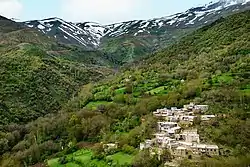 Miyane village | |
 Location of Kurdistan province within Iran | |
| Coordinates: 35°18′41″N 46°59′46″E / 35.3113°N 46.9960°E | |
| Country | Iran |
| Region | Region 3 |
| Capital | Sanandaj |
| Counties | 10 |
| Government | |
| • Governor-general | Esmaeil Zarei Kousha |
| • MPs of Assembly of Experts | Faegh Rostami and Seyed Mohammad Hosseini Shahroudi |
| • Representative of the Supreme Leader | Seyed Mohammad Hosseini Shahroodi |
| Area | |
| • Total | 29,137 km2 (11,250 sq mi) |
| Population (2015)[1] | |
| • Total | 1,603,011 |
| • Density | 55/km2 (140/sq mi) |
| Time zone | UTC+03:30 (IRST) |
| Main language(s) | Persian (official) local languages:[2] Ardalan languages |
| HDI (2017) | 0.743[3] high · 30th |
Kurdistan or Kordestan province (Persian: استان کردستان, romanized: Ostān-e Kordestān; Kurdish: پارێزگای کوردستان, romanized: Parêzgayî Kurdistan[4][5]) is one of the 31 provinces of Iran. The province is 28,817 km2 in area and its capital is the city of Sanandaj.[6] Other counties with their major cities are Saqqez, Baneh, Marivan, Qorveh, Bijar, Kamyaran, Dehgolan, Diwandarreh and Sarvabad.
Kurdistan province is located in the west of Iran, in Region 3. It borders the Kurdistan Region of Iraq to the west, and the Iranian provinces of West Azerbaijan to the north, Zanjan to the northeast, Hamadan to the east, and Kermanshah to the south.[7] It exists within both Iranian Kurdistan and Kurdistan.
At the National Census conducted in 2006, the province had a population of 1,416,334 inhabitants in 337,179 households.[8] The following census in 2011 counted 1,493,645 living in 401,845 households.[9] At the time of the most recent census in 2021, the population of the province had risen to 2,152,471 in 471,310 households.[1]
History
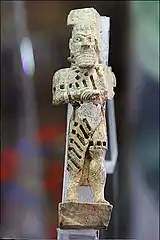
The earliest human occupation of Kurdistan dates back to the Paleolithic Period when Neanderthals lived in the Sirwan Valley of Kurdistan more than 40,000 years ago.[10]
Administrative divisions
Kurdistan province is sub-divided into 10 counties (shahrestan), with populations as follows at the 2006, 2011, and 2016 censuses. Each county is named after the city that serves as its administrative capital.
.svg.png.webp)
| Administrative Divisions | 2006[8] | 2011[9] | 2016[1] |
|---|---|---|---|
| Baneh County | 116,773 | 132,565 | 158,690 |
| Bijar County | 95,461 | 93,714 | 89,162 |
| Dehgolan County1 | — | 62,844 | 64,015 |
| Divandarreh County | 82,628 | 81,963 | 80,040 |
| Ghorveh County | 196,972 | 136,961 | 140,192 |
| Kamyaran County | 104,704 | 105,996 | 102,856 |
| Marivan County | 150,926 | 168,774 | 195,263 |
| Sanandaj County | 409,628 | 450,167 | 501,402 |
| Saqqez County | 205,250 | 210,820 | 226,451 |
| Sarvabad County | 53,992 | 49,841 | 44,940 |
| Total | 1,416,334 | 1,493,645 | 1,603,011 |
| 1Separated from Ghorveh County | |||
Cities
According to the 2016 census, 1,134,229 people (over 70% of the population of Kurdistan province) live in the following cities: Armardeh 2,305, Babarashani 509, Baneh 110,218, Bardeh Rasheh 1,020, Bijar 50,014, Bolbanabad 3,193, Buin-e Sofla 1,518, Chenareh 455, Dehgolan 25,992, Delbaran 6,713, Dezej 2,219, Divandarreh 34,007, Ghorveh 78,276, Kamyaran 57,077, Kani Dinar 13,059, Kani Sur 1,284, Marivan 136,654, Muchesh 3,370, Pir Taj 1,199, Saheb 3,101, Sanandaj 412,767, Saqqez 165,258, Sarvabad 5,121, Serishabad 7,196, Shuyesheh 1,302, Tup Aghaj 1,645, Uraman Takht 3,176, Yasukand 3,490, and Zarrineh 2,091.[1]
Most populous cities
The following sorted table lists the most populous cities in Kurdistan in 2016.[1]
| Rank | City | County | Population |
|---|---|---|---|
| 1 | Sanandaj | Sanandaj | 412,767 |
| 2 | Saqqez | Saqqez | 165,258 |
| 3 | Marivan | Marivan | 136,654 |
| 4 | Baneh | Baneh | 110,218 |
| 5 | Qorveh | Qorveh | 78,276 |
| 6 | Kamyaran | Kamyaran | 57,077 |
| 7 | Bijar | Bijar | 50,014 |
| 8 | Divandarreh | Divandarreh | 34,007 |
| 9 | Dehgolan | Dehgolan | 25,992 |
| 10 | Kani Dinar | Marivan | 13,059 |
Cultural
The people of Kurdistan have their own traditions and customs. Most of the people of this province speak Kurdish and other languages such as Azari and Farsi are also common in this province.[11]
Religion
A significant majority of the people of Kurdistan province follow the Sunni denomination of Islam. A minority of Shia, Yarsanism and Christian followers also live in this province.[12][13][14][15]
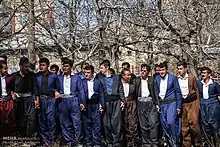
Clothing
The people of this province have special clothes that they have been wearing for centuries. The important point about the clothes of the people of this province is that even after the spread of modernism all over the world, the people of this province still try to be faithful to their past traditions in the field of lifestyle.[16][17][18][19][20]
Music and Dance
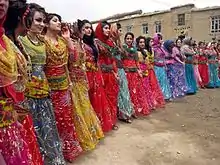
Among the cultural symbols of Kurdistan people are Kurdish dance and singing. This cultural tradition is very popular not only in this province but also throughout the country.
Important annual celebrations
Nowruz
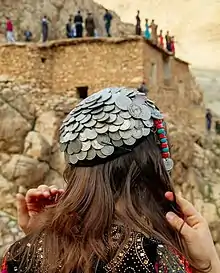
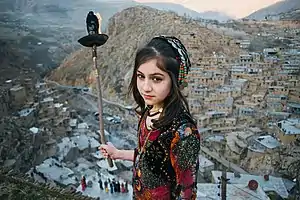

Nowruz is one of the most important ceremonies that has been celebrated among different people of Iran for millennia. Nowruz and related ceremonies are among the ceremonies that are celebrated in the most magnificent way possible in Kurdistan province. As the spring equinox, Nowruz marks the beginning of spring in the Northern Hemisphere, better i.e. the moment at which the Sun crosses the celestial equator and equalizes night and day is calculated exactly every year. Traditional customs of Nowruz include fire and water, ritual dances, gift exchanges, reciting poetry, symbolic objects and more.[11][21][22][23][24][25][26][27][28]
Chaharshanbeh Suri or Charshanbeh Suri is an Iranian festival of the fire dance celebrated on the eve of the last Wednesday of the year, of ancient Zoroastrian origin. It is the first festivity of Nowruz, the Iranian New Year. This festival is one of the oldest festivals held in Kurdistan province. In this celebration, people light fires on the mountains and on the roofs of houses, dance, rejoice and stomp their feet.[11][29][30][31]
Demographics
Kurds are the majority of the population, but Turkics populate the eastern provincial borderlands. Most of the Kurdish population speak Sorani Kurdish, but Southern Kurdish is spoken in the eastern parts of the province, including in Bijar and Dezej, while Gorani is the main language in many villages in the southwestern part of the province. Oghuz Turkic varieties can be found in the far-eastern part of the province, including in the cities of Delbaran, Pir Taj, Serishabad, Yasukand, and Tup Aghaj. These varieties are described as distinct from Iranian Azerbaijani, although they are closely related to it. While not being the primary language in any settlement in the province, Persian is increasingly becoming the first language, especially among the population in the eastern parts of the province.[2][16]
Economy
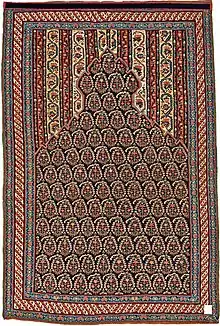
The major activities of the inhabitants are agriculture and modern livestock farming. Wheat, barley, grains and fruits are the major agricultural products. The chemical, metal, textile, leather and food industries are the main industrial activities in this province. This province has one of the largest rates of unemployment in Iran. According to Iranian statistics, more than twenty thousand people depend on being a kolbar for sustenance.[32][12]
Colleges and universities
See also
References
- 1 2 3 4 5 "Census of the Islamic Republic of Iran, 1395 (2016)". AMAR (in Persian). The Statistical Center of Iran. p. 12. Archived from the original (Excel) on 8 May 2022. Retrieved 19 December 2022.
- 1 2 3 Mohammadirad, Masoud (2016). "Language distribution: Kordestan Province". Iran Atlas.
- ↑ "Sub-national HDI - Area Database - Global Data Lab". hdi.globaldatalab.org. Retrieved 2018-09-13.
- ↑ "ئەنجوومەنی دادوەری ئێران بەدواداچوون بۆ دۆسیەی گەندەڵی لە پارێزگای کوردستان دەکات". Naskurd (in Kurdish). Retrieved 18 March 2020.
- ↑ "Parêzgeha Kurdistanê qaremana pêşbirkên werzişên zorxaneyî yên Îranê". Sahar. 16 September 2017. Retrieved 18 March 2020.
- ↑ "Sanandaj". Britannica. Retrieved 17 November 2020.
- ↑ "همشهری آنلاین-استانهای کشور به ۵ منطقه تقسیم شدند (Provinces were divided into 5 regions)". Hamshahri Online (in Persian). 22 June 2014. Archived from the original on 23 June 2014.
- 1 2 "Census of the Islamic Republic of Iran, 1385 (2006)". AMAR (in Persian). The Statistical Center of Iran. p. 12. Archived from the original (Excel) on 20 September 2011. Retrieved 25 September 2022.
- 1 2 "Census of the Islamic Republic of Iran, 1390 (2011)" (Excel). Iran Data Portal (in Persian). The Statistical Center of Iran. p. 12. Retrieved 19 December 2022.
- ↑ Biglari, F and S. Shidrang (2019) Rescuing the Paleolithic Heritage of Hawraman, Kurdistan, Iranian Zagros, Near Eastern Archaeology 82 (4): 226-235.https://doi.org/10.1086/706536
- 1 2 3 Ahmady, Kameel.2023. From Border to Border (Comprehensive research study on identity and ethnicity in Iran), Scholars’ Press publishes, Moldova.
- 1 2 Ahmady, Kameel (2022-08-25). "Ethnicity and Identities in Iran: Progress and Equality". International Journal of Kurdish Studies. 8 (2): 238–272. doi:10.21600/ijoks.1148638. ISSN 2149-2751.
- ↑ Department Of State. The Office of Electronic Information, Bureau of Public Affairs (2007-09-14). "Iran". 2001-2009.state.gov. Retrieved 2023-11-15.
- ↑ "The World Factbook — Central Intelligence Agency". web.archive.org. 2017-11-07. Retrieved 2023-11-15.
- ↑ "Mamouri, Ali (December 1, 2013). "Iranian government builds bridges to Sunni minority". Al-Monitor. Retrieved January 25, 2015".
- 1 2 Ahmady, Kameel (2022-01-25). "A Peace-Oriented Investigation of the Ethnic Identity Challenge in Iran (A Study of Five Iranian Ethnic Groups with the GT Method)". International Journal of Kurdish Studies. 8 (1): 1–40. doi:10.21600/ijoks.1039049. ISSN 2149-2751.
- ↑ Condra, Jill (2013-04-09). Encyclopedia of National Dress [2 volumes]. Santa Barbara, Calif: Bloomsbury Publishing USA. ISBN 978-0-313-37637-5.
- ↑ "Kurdish photos – 'A little Kurdish girl' Archived 2008-10-22 at the Wayback Machine".
- ↑ Foundation, Encyclopaedia Iranica. "Welcome to Encyclopaedia Iranica". iranicaonline.org. Retrieved 2023-11-15.
- ↑ "Clothing". Kurdish Central. Retrieved 2023-11-15.
- ↑ They celebrate the new year, which they call Chār shanba sur, on the first Wednesday of April, slightly later than the Iranian new year, Now-Ruz, on 21 March. (...) . The fact that Kurds celebrate the Iranian new year (which they call “Nawrôz” in Kurdish) does not make them Zoroastrian" – Richard Foltz (2017). "The “Original” Kurdish Religion? Kurdish Nationalism and the False Conflation of the Yezidi and Zoroastrian Traditions". Journal of Persianate Studies. Volume 10: Issue 1. pp. 93, 95
- ↑ Nations, United. "International Nowruz Day". United Nations. Retrieved 2023-11-15.
- ↑ "Kurdish Newroz". The Kurdish Project. Retrieved 2023-11-15.
- ↑ Plimmer, Joe (2023-03-21). "Nowruz: Kurdish new year 2023 celebrations – in pictures". the Guardian. ISSN 0261-3077. Retrieved 2023-11-15.
- ↑ "Nowruz: The Rebirth of Nature | Silk Roads Programme". en.unesco.org. Retrieved 2023-11-15.
- ↑ Khalid, Hewa Salam (2020). "Newroz from Kurdish and Persian Perspectives – A Comparative Study". Journal of Ethnic and Cultural Studies. 7 (1): 116–130. ISSN 2149-1291.
- ↑ "Nowruz Brings Kurdish Unrest In Iran's North West". Iran International. 2023-11-15. Retrieved 2023-11-15.
- ↑ "Nowruz 2023: Kurdish new year celebrations in pictures". euronews. 2023-03-24. Retrieved 2023-11-15.
- ↑ "Persian fire-jumping festival delights Berkeley residents". The Daily Californian. 2013-03-13. Retrieved 2023-11-15.
- ↑ Razavi, Mahboobeh (2019-03-01). "Chaharshanbe Suri: Experiencing Iran's Fiery Festival". SURFIRAN Mag. Retrieved 2023-11-15.
- ↑ "Encyclopædia Iranica", Wikipedia, 2023-11-09, retrieved 2023-11-15
- ↑ Fars News:The situation of kolbars vaguer than ever
Bibliography
- Ahmady, Kameel (2023). From Border to Border. Moldova: Scholars’ Press publishes. ISBN 9786206769538.
- Maisel, Sebastian (2018-06-21). The Kurds. Santa Barbara, California Denver, Colorado: Bloomsbury Publishing USA. p. 236. ISBN 978-1-4408-4257-3.
- Houtsma, Martijn Theodoor (1993). First Encyclopaedia of Islam, 1913-1936. Vol. 4 (1st ed.). Leiden: BRILL. p. 1140. ISBN 90-04-09790-2. OCLC 258059134.
